Understanding the New Train Driver Recruitment Tests
In this article we will provide you with new details of the train driver tests which came into force in 2013. These tests will be conducted by the majority of UK train operating companies.

Attention Test of Everyday Attention for Occupational assessment (TEA-Occ)
Attention is crucial for any train driver and, therefore, is heavily assessed in the train driver selection process. One of the methods of this assessment is achieved through the Attention Test of Everyday Attention for Occupational assessment (TEA-Occ).
The TEA provides a measure that is sensitive to sustained attention, selective attention and attentional switching. You attention will be tested by engaging with familiar everyday items such as telephone directories and looking for key symbols, this part of the test is called the telephone search.
Another subtest, the telephone search while counting involves you once again searching through a telephone directory, but this time simultaneously counting a run of tones played in the background.
The final subtest of the TEA is designed as a test of the auditory selective attention. You will be asked to pretend you are in a lift on the bottom floor but the lift’s floor indicator has broken therefore you have to determine which floor you arrive on by counting a series of low tones and ignoring high tones used a distraction.
The TEA is used to determine different patterns of attentional skills and provides a broad-based indication of the theoretical aspects of attention.
KEY SKILLS MEASURED IN THIS ASSESSMENT:
- Attention to detail;
- Meticulousness;
- Sustained attention and concentration over time – includes multi-taking elements.
KEY INFORMATION:
- Train Operating Companies across the UK do not stick to the same time limit;
- Typical time lengths for the TEA-Occ can range from 5 minutes, to 25 to minutes;
- As you can see, 5 minutes and 30 minutes is a huge difference. Generally, the more appealing and popular TOCs tend to set the bar higher; meaning their assessments are much more complex and gruesome.
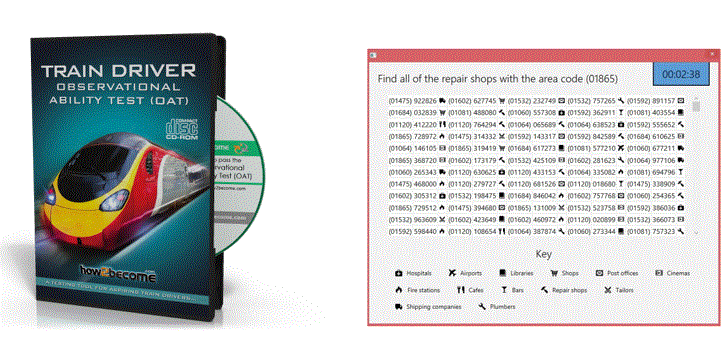
Group Bourdon
The Group Bourdon test is a train driver concentration test. It is also referred to as the dots test. It is designed to measure a train driver’s ability to maintain concentration and accuracy for a long period of time. As a train driver, you have the responsibility for the safety of yourself, the crew members and the passengers, which is of the utmost importance. Due to this the test is often used to eliminate many candidates from the selection process early on.
The Group Bourdon test is a psychometric test used to access your ability to maintain diligence, speed, accuracy and concentration whilst looking for a cluster of 4 dots. If you chose groups of dots other than that of groups of four, you will lose marks. Consistency is key.
Scoring well on the Group Bourdon test will show the recruiters that you have the qualities needed to become a safe train driver.
KEY SKILLS MEASURED IN THIS ASSESSMENT:
- Visual perception;
- Attentiveness, alertness and concentration;
- Maintaining speed, diligence and accuracy over prolonged periods of time.
KEY INFORMATION:
- Train Operating Companies across the UK do not stick to the same time limit;
- The Group Bourdon test comprises of 5 sheets, with approximately 2 minutes spent per sheet;
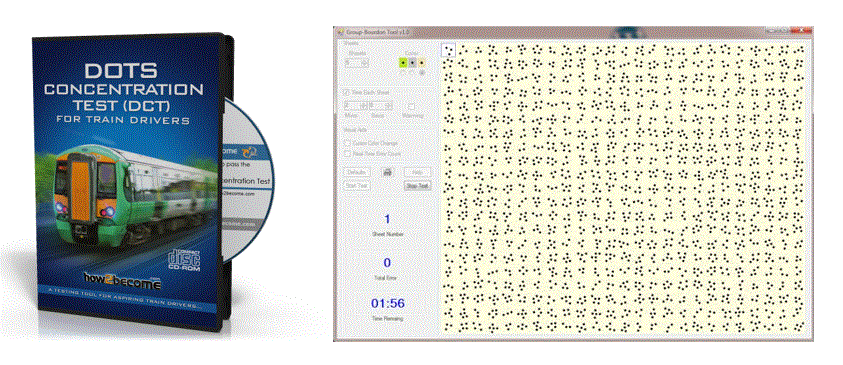
Vigilance WAFV
There are 6 parts to the WAFV test but for vigilance it consists of two main tests; visual and auditory. It is a computerised assisted test in which you have to respond to the change in intensity of the visual and auditory elements presented top you. It is essentially an attention test that is completed on average within 15 minutes.
KEY SKILLS MEASURED IN THIS ASSESSMENT:
- Quick reactions;
- Visual and auditory skills;
- Ability to observe, analyse, and be vigilant in pressurised situations.
KEY INFORMATION:
- Train Operating Companies across the UK do not stick to the same time limit;
- Typically, you will get approximately 25 to minutes to complete this test.
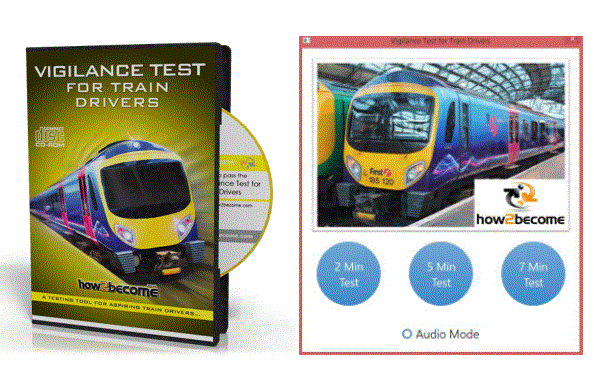
MEMORY ABILITY TESTS (PART 1)
The Memory Ability Test is a specifically designed test for train drivers and is presented in two main parts. Its purpose is to give the assessors an implication of your potential to be successful throughout training. The first part of the test examines your ability to maintain and recall job-related knowledge.
Testing your memory, the first part of the test will involve the listening of a fictitious recording of safety-related rules. You are required to learn the rules and recall them from memory answering the 18 questions that will be presented to you. Materials include a question booklet, information sheet, CD/cassette tape, answer sheet, and scoring keys.
A good performance on the test can often be linked with the actual train driving performance and, therefore, the Memory Ability Test has been identified as to having a significant impact on the selection of train drivers in the UK.
Reasoning Ability Tests (Part 2)
The second part of the Ability Test examines your ability for learning new concepts that represent those encountered in driver training. You will be presented with fictitious dials that represent those seen inside of a train cab and also rules relating to how they function. You will have to apply these rules in order to make a decision on which dials should be checked. There are around 40 dials that you will have to check in this test.
The Ability Test part 2 will attempt to measure your ability to learn and pick up a new range of ideas and concepts. Most of these concepts will be completely new to you and therefore you will be required to learn them and apply them quickly.
Perception Adaptive Tachistoscopic Traffic Test (ATAVT)
The ATAVT is designed to test your observational ability by quickly presenting pictures of traffic conditions on a screen. The picture is briefly visible for around 1 second and after seeing each picture you will be asked to identify what the picture contained from a list of 5 options. The process then repeats.
An example of the process may be you being shown an image containing 2 cars and a pedestrian in a busy town, you will have to select after seeing the image ‘pedestrians’ and also ‘motorcars’ from the list of available options. The difficulty of the items presented within the image are adaptive and will change in difficulty depending on your ability in speed and accuracy.
This test will access your speed of perception, visual observation and ability to maintain an overview of that observation.
KEY SKILLS MEASURED IN THIS ASSESSMENT:
- Observation skills;
- Ability to quickly take in information;
- Attention to detail
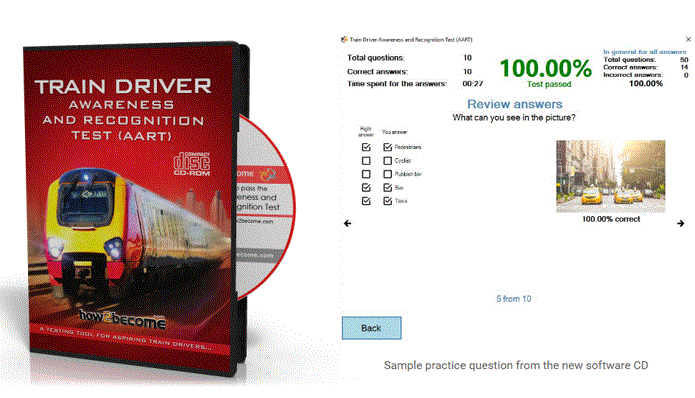
Reaction time WAFV
The trainee train driver selection process accesses your ability to react fast and accurately through the Reaction Time WAFV. It is utilised to measure how well you can concentrate intently whilst you react to timed events presented on screen. It is a computerised test in which you are first assessed on your own pace and then you are assessed at the computer’s pace. It will test your ability to focus on the task at hand by having the ability to continue the test fully focussed even if you realise you’ve made a mistake.
KEY SKILLS MEASURED IN THIS ASSESSMENT:
- Quick reactions;
- Visual and auditory skills;
- Ability to observe, analyse, and be vigilant in pressurised situations.
KEY INFORMATION:
- Train Operating Companies across the UK do not stick to the same time limit;
- Typically, you will get approximately 25 to minutes to complete this test.

Hand coordination 2HAND
The purpose of the 2HAND test is to reliably asses your eye-to-hand and hand-to-hand coordination. The task will involve you controlling a red dot which you have to guide along a given track. This will be done by using either two control knobs or joysticks. The track in which you need to guide the red dot along consists of three sections that will make various demands on your ability to coordinate your left and right hand. This is the greatest difficulty of the task; being able to coordinate both hands in the need to make the correct visual assessment. Anticipation of direction also plays a big part.
KEY SKILLS MEASURED IN THIS ASSESSMENT:
- Hand-eye coordination;
- Motor skills.
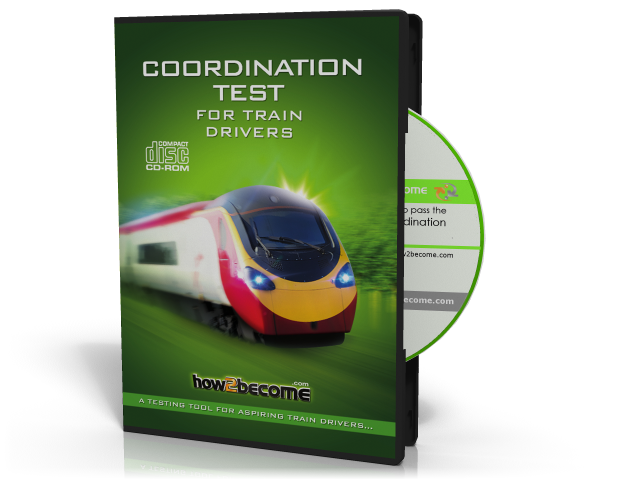
Written Communication Test (WCT)
The WCT is designed to test the train driver’s communicational skills with other people in a written form. It will test how clear and informative your written piece of communication is. Written communication skills are indeed important to the train driver role and it does coincide with safety but the vast majority of a train driver’s written tasks are completed whilst not in control of a train i.e. during a work break or completed at the depot. Therefore, written communication is not time critical and a lack of communication skill will not result in a train driving error.
Relevant behavioural/personality attributes Situational Judgement Exercise (SJE)
The situational judgement exercise (SJE) is a multiple choice test that presents a range of different situations that you encounter in an actual train driver role. The exercise will ask you to select the most appropriate behavioural responses to those situations, or the behavioural responses that you yourself would chose. There are normally between 4-5 possible actions to choose from and it will be your task to distinguish which is the most effective course of action to take (i.e. the action you would make yourself if the situation were real).
Train operating companies use SJEs as part of the selection process as it provides strong evidence for situation-based measures in predicating your job performance. It will be used to identify the potential strong performers within the selection process.
KEY SKILLS MEASURED IN THIS ASSESSMENT:
- Analytical skills;
- Strong written communication;
- Communication skills.
KEY INFORMATION:
- Train Operating Companies across the UK do not stick to the same time limit;
- Typically, you will have 11 minutes for this exercise 3 minutes will be spent analysing pictures, and the remaining 8 minutes will be spent writing a report.
Multimodal Interview (MMI)
The Multi-Modal Interview is developed to work in conjunction with the Situational Judgement Exercise (SJE). Its purpose is to access your verbal communication and the behavioural selection criteria. You will be assessed on your ability to be able to communicate work related information in a clear and accurate manor. Once again, safety is one of the key elements that the recruiters will assess you on. So being able to verbally communicate safety-critical information is a must.
